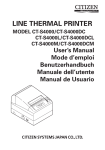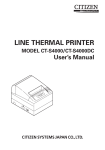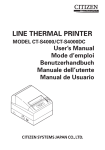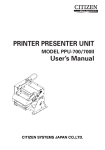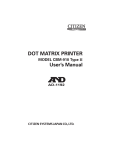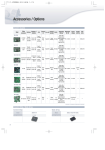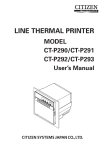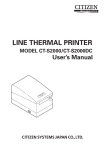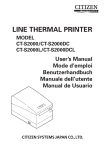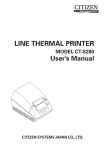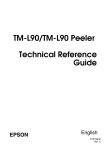Download Citizen CY 720 User`s manual
Transcript
LINE THERMAL PRINTER
MODEL CT-S4000/CT-S4000DC
CT-S4000L/CT-S4000DCL
CT-S4000M/CT-S4000DCM
User’s Manual
WEEE MARK
En
,I\RXZDQWWRGLVSRVHWKLVSURGXFWGRQRWPL[ZLWKJHQHUDOKRXVHKROGZDVWH7KHUHLVD
VHSDUDWHFROOHFWLRQV\VWHPVIRUXVHGHOHFWURQLFVSURGXFWVLQDFFRUGDQFHZLWKOHJLVODWLRQXQGHU
WKH:((('LUHFWLYH'LUHFWLYH(&DQGLVHIIHFWLYHRQO\ZLWKLQ(XURSHDQ8QLRQ
Ge
:HQQ6LHGLHVHV3URGXNWHQWVRUJHQZROOHQGDQQWXQ6LHGLHVELWWHQLFKW]XVDPPHQPLWGHP
+DXVKDOWVPOO(VJLEWLP5DKPHQGHU:((('LUHNWLYHLQQHUKDOEGHU(XURSlLVFKHQ8QLRQ
'LUHNWLYH(&JHVHW]OLFKH%HVWLPPXQJHQIUVHSDUDWH6DPPHOV\VWHPHIUJHEUDXFKWH
HOHNWURQLVFKH*HUlWHXQG3URGXNWH
Fr
6LYRXVVRXKDLWH]YRXVGpEDUUDVVHUGHFHWDSSDUHLOQHOHPHWWH]SDVjODSRXEHOOHDYHFYRV
RUGXUHVPpQDJqUHV,OH[LVWHXQV\VWqPHGHUpFXSpUDWLRQGLVWLQFWSRXUOHVYLHX[DSSDUHLOV
pOHFWURQLTXHV FRQIRUPpPHQW j OD OpJLVODWLRQ :((( VXU OH UHF\FODJH GHV GpFKHWV GHV
pTXLSHPHQWVpOHFWULTXHVHWpOHFWURQLTXHV'LUHFWLYH(&TXLHVWXQLTXHPHQWYDODEOH
GDQVOHVSD\VGHO¶8QLRQHXURSpHQQH
/HVDSSDUHLOVHWOHVPDFKLQHVpOHFWULTXHVHWpOHFWURQLTXHVFRQWLHQQHQWVRXYHQWGHVPDWLqUHV
GDQJHUHXVHVSRXUO¶KRPPHHWO¶HQYLURQQHPHQWVLYRXVOHVXWLOLVH]HWYRXVYRXVHQGpEDUUDVVH]
GHIDoRQLQDSSURSULpH
Sp
6LGHVHDGHVKDFHUVHGHHVWHSURGXFWRQRORPH]FOHFRQUHVLGXRVGRPpVWLFRVGHFDUiFWHU
JHQHUDO([LVWHXQVLVWHPDGHUHFRJLGDVHOHFWLYDGHDSDUDWRVHOHFWUyQLFRVXVDGRVVHJ~Q
HVWDEOHFHODOHJLVODFLyQSUHYLVWDSRUOD'LUHFWLYD&(VREUHUHVLGXRVGHDSDUDWRV
HOpFWULFRV\HOHFWUyQLFRV5$((YLJHQWH~QLFDPHQWHHQOD8QLyQ(XURSHD
It
6HGHVLGHUDWHJHWWDUHYLDTXHVWRSURGRWWRQRQPHVFRODWHORDLULILXWLJHQHULFLGLFDVD(VLVWH
XQVLVWHPDGLUDFFROWDVHSDUDWRSHULSURGRWWLHOHWWURQLFLXVDWLLQFRQIRUPLWjDOODOHJLVOD]LRQH
5$(('LUHWWLYD&(YDOLGDVRORDOO¶LQWHUQRGHOO¶8QLRQH(XURSHD
Du
'HSRQHHUGLWSURGXFWQLHWELMKHWJHZRQHKXLVKRXGHOLMNDIYDOZDQQHHUXKHWZLOWYHUZLMGHUHQ(U
EHVWDDW LQJHYROJH GH :(((ULFKWOLMQ 5LFKWOLMQ (* HHQ VSHFLDDO ZHWWHOLMN
YRRUJHVFKUHYHQYHU]DPHOV\VWHHPYRRUJHEUXLNWHHOHNWURQLVFKHSURGXFWHQZHONDOOHHQJHOGW
ELQQHQGH(XURSHVH8QLH
Da
+YLVGXYLOVNLOOHGLJDIPHGGHWWHSURGXNWPnGXLNNHVPLGHGHWXGVDPPHQPHGGLWDOPLQGHOLJH
KXVKROGQLQJVDIIDOG'HUILQGHVHWVHSDUDWLQGVDPOLQJVV\VWHPIRUXGWMHQWHHOHNWURQLVNHSURGXNWHU
LRYHUHQVVWHPPHOVHPHGORYJLYQLQJHQXQGHU:(((GLUHNWLYHWGLUHNWLY(&VRP
NXQHUJ OGHQGHLGHQ(XURS LVNH8QLRQ
Por 6HTXLVHUGHLWDUIRUDHVWHSURGXWRQmRRPLVWXUHFRPROL[RFRPXP'HDFRUGRFRPDOHJLVODomR
TXHGHFRUUHGD'LUHFWLYD5(((±5HVtGXRVGH(TXLSDPHQWRV(OpFWULFRVH(OHFWUyQLFRV
&(H[LVWHXPVLVWHPDGHUHFROKDVHSDUDGRSDUDRVHTXLSDPHQWRVHOHFWUyQLFRVIRUDGH
XVRHPYLJRUDSHQDVQD8QLmR(XURSHLD
Pol -HĪHOL]DPLHU]DV]SR]E\üVLĊWHJRSURGXNWXQLHZ\U]XFDMJRUD]HP]H]Z\Ná\PL
GRPRZ\PLRGSDGNDPL:HGáXJG\UHNW\Z\:((('\UHNW\ZD(&
RERZLą]XMąFHMZ8QLL(XURSHMVNLHMGODXĪ\ZDQ\FKSURGXNWyZHOHNWURQLF]Q\FK
QDOHĪ\VWRVRZDüRGG]LHOQHVSRVRE\XW\OL]DFML
Declaration of Conformity
This printer conforms to the following Standards:
The Low Voltage Directive 2006/95/EC, formerly 72/23/EEC,
the EMC Directive 2004/108/EC, formerly 89/336/EEC, the RoHS
Directive 2002/95/EC, and the WEEE Directive 2002/96/EC.
LVD : EN60950
EMC : EN55022
EN61000-3-2
EN61000-3-3
EN55024
Class A
This declaration is applied only for 230V model.
IMPORTANT: This equipment generates, uses, and can radiate radio frequency energy
and if not installed and used in accordance with the instruction manual, may cause
interference to radio communications. It has been tested and found to comply with
the limits for a Class A computing device pursuant to Subpart J of Part 15 of FCC
Rules, which are designed to provide reasonable protection against such interference
when operated in a commercial environment. Operation of this equipment in a
residential area is likely to cause interference, in which case the user at his own
expense will be required to take whatever measures may be necessary to correct
the interference.
CAUTION: Use shielded cable for this equipment.
Sicherheitshinweis
Die Steckdose zum Anschluß dieses Druckers muß nahe dem Gerät angebracht und
leicht zugänglich sein.
For Uses in Canada
This Class A digital apparatus complies with Canadian ICES-003.
This digital apparatus does not exceed the class A limits for radio noise emissions
from digital apparatus, as set out in the radio interference regulations of the Canadian
department of communications.
Pour L’utilisateurs Canadiens
Cet appareil numérique de la classe A est conforme à la norme NMB-003 du Canada.
Cet appareil numérique ne dépasse pas les limites de carégorie a pour les émissions
de bruit radio émanant d’appareils numériques, tel que prévu dans les réglements
sur l’interférence radio du départment Canadien des communications.
GENERAL PRECAUTIONS
● Before using this product, be sure to read through this manual. After having read
this manual, keep it in a safe, readily accessible place for future reference.
● The information contained herein is subject to change without prior notice.
● Reproduction or transfer of part or all of this document in any means is prohibited
without permission from Citizen Systems.
● Note that Citizen Systems is not responsible for any operation results regardless
of missing, error, or misprinting in this manual.
● Note that Citizen Systems is not responsible for any trouble caused as a result of
using options or consumables that are not specified in this manual.
● Except explained elsewhere in this manual, do not attempt to service, disassemble,
or repair this product.
● Note that Citizen Systems is not responsible for any damage attributable to
incorrect operation/handling or improper operating environments that are not
specified in this manual.
● Data is basically for temporary use and not stored for an extended period of time
or permanently. Please note that Citizen Systems is not responsible for damage
or lost profit resulting from the loss of data caused by accidents, repairs, tests or
other occurrence.
● If you find loss of information, error, or uncertain matter, please contact your
Citizen Systems dealer.
● If you find any disordered or missing page(s), contact your Citizen Systems dealer
for replacement.
CITIZEN is a registered trade mark of Citizen Holdings Co., Japan
CITIZEN es una marca registrada de Citizen Holdings Co., Japón
Company names and product names in this manual are trademarks or
registered trademarks of relevant companies.
Copyright c 2009 by CITIZEN SYSTEMS JAPAN CO., LTD.
—1—
SAFETY PRECAUTIONS ... WHICH SHOULD BE STRICTLY OBSERVED
Before using this product for the first time, carefully read these SAFETY PRECAUTIONS.
Improper handling may result in accidents (fire, electric shock or injury).
In order to prevent injury to operators, third parties, or damage to property, special
warning symbols are used in the User’s Manual to indicate important items to be strictly
observed.
● After having read this Manual, keep it in a safe, readily accessible place for future
reference.
● Some of the descriptions contained in this manual may not be relevant to some printer
models.
The following describes the degree of hazard and damage that could occur if the printer
is improperly operated by ignoring the instructions indicated by the warning symbols.
WARNING
Neglecting precautions indicated by this symbol may result in fatal or serious injury.
CAUTION
Neglecting precautions indicated by this symbol may result in injury or damage to
properties.
This symbol is used to alert your attention to important items.
This symbol is used to alert you to the danger of electric shock or electrostatic
damage.
This symbol denotes a request to unplug the printer from the wall outlet.
This symbol is used to indicate useful information, such as procedures, instructions
or the like.
This symbol is used to indicate prohibited actions.
—2—
PRECAUTIONS ON PRINTER INSTALLATION
WARNING
■ Do not use or store this product in a place where it will be exposed
to:
* Flames or moist air.
* Direct sunlight.
* Hot airflow or radiation from a heating device.
* Salty air or corrosive gases.
* Ill-ventilated atmosphere.
* Chemical reactions in a laboratory.
* Airborne oil, steel particles, or dust.
* Static electricity or strong magnetic field.
• Neglecting these warnings may result in printer failure, overheating,
emission of smoke, fire, or electric shock.
■ Do not drop any foreign object nor spill liquid into the printer. Do not
place any object on the printer either.
■ Do not drop any metallic object such as paper clip, pin or screw into
the printer.
■ Do not place a flower vase, pot or cup containing water on the printer.
■ Do not spill coffee, soft drinks or any other liquid into the printer.
■ Do not spray insecticide or any other chemical liquid over the printer.
• A metallic foreign object, if accidentally dropped into the printer, may
cause printer failure, fire, or electric shock. Should it occur,
immediately turn the printer off, unplug it from the supply outlet,
and call your local Citizen Systems dealer.
Do not handle the printer in the following ways:
■ Do not allow the printer to sustain strong impacts or hard jolts (e.g.,
trampling, dropping, striking with a hard edge).
■ Never attempt to disassemble or modify the printer.
• Neglecting to handle properly may result in printer failure,
overheating, emission of smoke, fire, or electric shock.
■ Install, use, or store the printer out of the reach of children.
• Electric appliances could cause an unexpected injury or accident if
they are handled or used improperly.
• Keep the power cord and signal cables out of the reach of children.
Also children should not be allowed to gain access to any internal
part of the printer.
• The plastic bag the printer came in must be disposed of properly or
kept away from children. Wearing it over the head may lead to
suffocation.
—3—
CAUTION
Do not use the printer under the following conditions.
■ A state subject to vibration or unstable state.
■ A state with this product slanted.
• Otherwise dropping may cause injury.
• Poor print quality may occur.
■ A state where the printer ventilation holes are obstructed by a nearby
wall or other equipment.
■ A state where any object is placed on the printer
■ A state where the printer is covered or wrapped by a cloth or bed
clothing
• Be careful about internal heat buildup, which could cause fire and
deform the case.
■ Avoid using the printer near a radio or TV set or from supplying it
from the same outlet as these appliances.
■ Avoid using the printer interconnected with a cable or cord that has
no protection against noise. (For interconnections, use shielded or a
twisted pair of cables and ferrite cores, or other anti-noise devices.)
■ Avoid using the printer with a device that is a strong source of noise.
• The printer may have an adverse effect on nearby radio or TV
transmissions. There may also be cases when nearby electrical
appliances adversely influence the printer, causing data errors or
malfunction.
■ A state where this product is installed sidelong.
• Malfunction, failure, or electric shock may result.
■ Use the printer with its grounding post connected to a convenient
grounding facility.
• If leakage occurs electric shock may result.
■ Do not connect the printer’s grounding post onto any of the following
facilities:
* Utility gas piping
• A gas explosion could result.
* Telephone line ground
* Lightning rod
• If lightning strikes a large surge of current may cause fire or
shock.
* Utility water pipes
• Plastic water pipes should not be used for grounding. (Those
approved by a Waterworks Department may be used.)
■ Before connecting or disconnecting the grounding lead to or from
the printer, always unplug it from supply outlet.
—4—
PRECAUTIONS IN HANDLING THE PRINTER
WARNING
Please observe the following precautions for power source and power
cord:
■ Do not plug or unplug the power cord with a wet hand.
■ Use the printer only at the specified supply voltage and frequency.
■ Check to make sure that the supply outlet from which the printer is
powered has a sufficient capacity.
■ Do not supply the printer from a power strip or current tap shared
with other appliances.
■ Do not plug the power cord into a supply outlet with dust or debris
left on its plug.
■ Do not use a deformed or damaged power cord.
■ Do not move the printer while the printer power is on.
• Neglecting to handle properly may result in printer failure, emission
of smoke, fire, or electric shock.
• An overload may cause the power cord to overheat or fire or the circuit
breaker to trip.
■ Do not allow anything to rest on the power cord. Do not place the
printer where the power cord will be trampled on.
■ Do not use or carry the printer with its power cord bent, twisted, or
pulled.
■ Do not attempt to modify the power cord unnecessarily.
■ Do not lay the power cord in the neighbor of a heating device.
• Neglecting these cautions may cause wires or insulation to break,
which could result in leakage, electric shock, or printer failure. If the
power cord sustains damage, contact your Citizen Systems dealer.
■ Do not leave things around the supply outlet.
■ Supply power to the printer from a convenient wall outlet, readily
accessible in an emergency.
• The printer may not be immediately shut down in an emergency.
■ Insert the power plug fully into the outlet.
■ If the printer will not be used for a long time, leave it disconnected
from its supply outlet.
■ Hold the plug and connector when plugging or unplugging the power
cord or signal cable after turning off the printer and the appliance
connected to it.
—5—
CAUTION
Caution label is attached on the position shown in the following figure. Carefully
read the precautions in handling before using the printer.
THESE LABELS INDICATE THE
RISK OF ANY INJURY DUE TO
"HIGH TEMPERATURE" OF
THE PRINT HEAD AND "SAWTOOTHED EDGE" OF THE
MANUAL CUTTER.
■ Do not transport this printer with the paper roll inside.
• Printer failure or breakage may occur.
To prevent possible malfunction or failure observe the following.
■ Avoid operating the printer without paper properly loaded.
■ Avoid the use of paper not complying with specifications.
• May result in poor print quality.
■ Avoid using torn pieces of paper or spliced with plastic adhesive
tapes.
■ Avoid forcibly pulling already loaded paper by hand.
■ Avoid wedging the paper into the printer.
• May jam paper. To release, refer to “Removing Jammed Paper” in
this manual.
■ Avoid using a sharp pointed device to operate panel keys.
■ Be sure to firmly insert the cable plug into its mating socket.
• A cross connection may damage the printer’s internal electronics or
the host system’s hardware.
■ Only use the printer with devices that have designated solenoid
specifications for the cash drawer interface connector.
• Neglecting this caution may result in malfunction or failure.
—6—
CAUTION
To prevent injury and printer failures from worsening, observe the
following:
■ Do not touch the printing surface of the thermal head.
■ Do not touch any of the moving parts (e.g., paper cutter, gears, active
electrical parts) while the printer is working.
■ In case of trouble do not attempt to repair the printer. Ask Citizen
Systems service for repair.
■ Be careful that the printer cover does not entrap your hands or fingers.
■ Be careful with sharp edges on the printer. Do not allow them to
injure you or damage property.
• May result in electric shock, burn, or injury.
If the printer emits smoke, an odd smell, or unusual noise while printing,
immediately abort the current print session and unplug the printer from
the supply outlet.
DAILY MAINTENANCE
Observe the following precautions for daily maintenance.
■ When cleaning the printer, always turn it off and unplug it from the
supply outlet.
■ Use a soft, dry cloth for cleaning the surface of the printer case.
■ For severe stains, use a soft cloth slightly dampened with water.
■ Never use organic cleaning solvent such as alcohol, paint thinner,
trichloroethylene, benzene, or ketone. Never use a chemically
processed cleaning cloth.
■ To remove paper dust, use a soft brush.
CAUTION
• The thermal head is at a dangerously high temperature immediately
after printing. Allow it to cool off before launching maintenance work.
—7—
THE TABLE OF CONTENTS
1. GENERAL OUTLINE .................................................................... 9
1.1
1.2
1.3
1.4
Features ..........................................................................................9
Unpacking .....................................................................................10
Model Classification ..................................................................... 10
Basic Specifications ..................................................................... 11
2. EXPLANATION OF PRINTER PARTS........................................ 12
2.1 Printer Appearance ...................................................................... 12
2.2 Printer Cover Inside ..................................................................... 14
2.3 Other Built-in Functions ............................................................... 14
3. PREPARATION ........................................................................... 15
3.1
3.2
3.3
3.4
3.5
3.6
3.7
Connecting the AC Power Cord .................................................. 15
Connecting Interface Cables ....................................................... 16
Connecting the Cash Drawer ...................................................... 17
Installing the Printer ..................................................................... 18
Partition for Paper Roll ................................................................ 18
Setting DIP Switch ....................................................................... 19
Adjusting the Paper Near-end Sensor ........................................ 20
4. MAINTENANCE AND TROUBLESHOOTING ........................... 21
4.1
4.2
4.3
4.4
4.5
4.6
4.7
Setting/Replacing the Paper Roll ................................................ 21
Removing Jammed Paper ........................................................... 21
Periodic cleaning ..........................................................................22
Self-printing .................................................................................. 23
Hexadecimal Dump Printing ....................................................... 23
Error Indication .............................................................................24
When the Paper Cover Cannot Be Opened ................................ 25
5. OTHER ....................................................................................... 26
5.1
5.2
5.3
5.4
5.5
5.6
External Views and Dimensions ................................................. 26
Printing Paper ............................................................................... 26
Manual Setting of Memory Switch ............................................. 29
Selecting paper type .................................................................... 32
Adjusting paper sensor ............................................................... 32
Full cutting label paper ................................................................ 34
—8—
1. GENERAL OUTLINE
This product are thermal line printers designed for use with a broad array of
terminal equipment including data, POS, and kitchen terminals.
With extensive features, they can be used in a wide range of applications.
1.1 Features
● Versatile roll capacity with ability to use 80 mm, 82.5 mm and 112 mm wide
paper rolls.
● Can use paper roll with a maximum of 102 mm diameter.
● Drop-in paper loading mechanism facilitating easy paper handling and head
cleaning.
● High speed (150 mm/s) printing.
● Equipped with USB interface as standard plus a choice of either a serial or
parallel interface.
● Replaceable interface board.
● High-speed parallel interface (Parallel interface model)
● Built-in cash drawer interface.
● Auto cutter mechanism provided as a standard.
● User customization such as memory switch setting are available.
● Page mode
● Registration of user-defined characters and logos into flash memory.
● Barcode & 2D Barcode printing is supported.
● 2-color printing is supported (When specified paper is used).
● Error indication is available with LED or buzzer.
[Only CT-S4000L, CT-S4000DCL]
● High speed (132 mm/s) printing.
●Label paper of 58 to 107 mm wide in addition to 112-mm wide label paper is
usable without step.
[Only CT-S4000L, CT-S4000DCL, CT-S4000M, CT-S4000DCM]
● Paper sensor sensitivity adjustment system by volume is adopted.
—9—
1.2 Unpacking
When unpacking the printer, confirm that the following are provided:
● Printer:
● AC power cord :
● CD-ROM:
● Sample paper roll:
● Partition:
● Screw:
● Quick start guide:
1
1 (for CT-S4000, CT-S4000L, CT-S4000M)
1
1 roll
1
1
1
AC power cord
CD-ROM
CT-S4000
Sample paper roll
Partition
Screw
Quick start guide
1.3 Model Classification
The printer models are classified by the following designation method:
CT - S4000
RS E - BK Label/Black mark
No marking: Standard
L: Label
M: Black mark
Power supply
No marking: AC power type
(built-in power supply)
DC: DC power supply type
Body case color
WH: Cool white
BK: Black
Interface
PA: IEEE1284 & USB
RS: RS-232C & USB
UB: USB only (Option)
Character set, AC cable,
E: Europe
U: USA
*Description marked “*L” in this manual is the description for CT-S4000L/CT-S4000DCL and that
marked “*M” for CT-S4000M/CTS4000DCM. Read this manual after confirming your model in
use.
— 10 —
1.4 Basic Specifications
Item
Specifications
CT-S4000 PA/RS/UB, CT-S4000DC PA/RS/UB
Model
Print method
Line thermal dot print method
Print width *1
104 mm/832 dots, 82.5 mm/660 dots, 72 mm/576 dots
104 mm/832 dots, 72 mm/576 dots, 50 mm/400 dots
Dot density
8 dots/mm (203 dpi) in holizontal & vertical
Print speed
150 mm/s (Fastest, print density 100 %), 1200 dot lines/s
Only in label mode, 132 mm/s (max), print density level is 88%, and 1056 dot lines/s.
Number of print columns
Dot configuration
(columns)
(Dot)
Paper width
112mm 82.5mm 80mm 58mm*L
Font
Number of print
columns *2
Character size
*3
Character type
Font A
69
55
48
33
Font B
92
73
64
44
12 × 24
9 × 24
Font C
104
82
72
50
8 × 16
Font A: 1.50 × 3.00 mm Font B: 1.13 × 3.00 mm Font C: 1.00 × 2.00 mm
Alphanumeric, International, PC437 PC850/852/857/858/860/863/864/
865/866/WPC1252/Katakana/Thai code 18
User memory
384 KB (Capable of registering user-defined characters and logos)
Types of barcode and
2D barcode
UPC-A/E, JAN (EAN) 13/8 columns, ITF, CODE 39, CODE 128,
CODABAR, CODE 93, PDF417, QR Code
Line spacing
4.23 mm (1/6 inch)
*4
0
0
0
Paper roll
Thermal paper roll: 112 −1 mm/82.5 −1 mm/80 −1 mm ×Maximum φ102 mm
Paper thickness: 65-150 µm
Interfacing
Serial (RS-232C compliant), Parallel (IEEE 1284 compliant), USB
Cash drawer interface
2 cash drawers are supported.
Input buffer
4K bytes/45 bytes (selectable) in Serial or Parallel interface, 16K bytes in
USB interface
Supply voltage
AC100 to 240V, 50/60 Hz, 130VA / DC24V, 2.0A
Power consumption
Approx. 70W (in normal printing)
Weight
Approx. 2.3 Kg for CT-S4000, CT-S4000L, CT-S4000M
Approx. 2.0 Kg for CT-S4000DC, CT-S4000DCL, CT-S4000DCM
Outside dimensions
177 (W) × 213 (D) × 147 (H) mm
Operating temperature 5 to 45°C, 10 to 90% RH (No condensation)
and humidity
Storage temperature
and humidity
−20 to 60°C, 10 to 90% RH (No condensation)
Reliability
Print head life: 100 km, 1 × 108 pulses (At normal temperature/
humidity with recommended paper used)
Auto cutter life:1 million cuts (At normal temperature/
humidity with recommended paper used)
Safety standard
UL, C-UL, FCC Class A, TÜV-GS, CE Marking
Notes:
*1: When paper width is 112, 82.5, 80 mm
*2: The number of printable columns are selectable with a Memory Switch.
The number of columns in this table refers to typical model. Printer varies partly in the number
of columns depending on printer specifications.
*3: As each character size includes the space inside the character font, actual character looks
smaller.
*4: The line spacing is selectable with a command or Memory Switch. When the printer is turned
on, it will be slelecte with the memory switch.
— 11 —
2. EXPLANATION OF PRINTER PARTS
2.1 Printer Appearance
Printer cover
Cover open button
Side opening
Power switch
Operation panel
(Front view)
Side opening
Rear connector
(Rear view)
● Printer cover
Paper is loaded under this cover.
● Cover open button
To refill or replace paper, open the printer cover by pulling the cover open
button forward.
● Power switch
This switch turns the printer power ON/OFF.
● Side opening
The cables connected to the printer can be routed through this side opening.
(Before use, push the small plastic barrier on the cover until it brakes.)
— 12 —
Operation Panel
POWER LED
ERROR LED
FEED button
● POWER LED
Illuminated when the printer power is on and off when the printer power is
off. May blink or light in a special mode or in case of failure.
● ERROR LED
Illuminated or blinks when paper is empty or in case of failure.
The interval length of blinking represents the type of error.
● FEED button
Pressing this button once causes the paper to feed one line. The longer the
button is pressed, the more paper is fed.
Pressing this button causes the paper to feed to the next Black Mark position
in Black Mark mode.
See 5.3 Manual Setting of Memory Switch
In case of auto cutter error, press the FEED button after removing the cause
of the error.
See 4.6 Error Indication
Rear Connectors
Interface connector
(Serial, parallel, etc.)
Cash drawer
kick-out connector
Power connector
(DC power supply type)
Interface board
AC inlet
(AC power type) mounting screws
USB connector
● Interface connector (Serial, parallel, etc.)
Connects to the interface cable. A DIP switch is provided on the serial interface
board.
● Cash drawer kick-out connector
Connects to the cable from the cash drawer.
●AC inlet (AC power type)
Connects to the AC power cord.
● Power connector (DC power supply type)
Connects to the cable from DC power source.
— 13 —
2.2 Printer Cover Inside
Manual cutter
● Paper feed roller
Feeds paper as part of print
mechanism.
● Paper-near-end sensor
Detects near paper end, change
position in accordance with the
outer diameter of paper core.
● Auto cutter
Cuts the paper with a command
at the end of printing. Cutting
method is selectable between
partial cut and full cut with a
command.
* Factory default of the memory
SW4-8 is set to "Partial cut", so that
a command will be ignored.
However, full cutting is set for the
model supporting label.
Paper feed roller
Paper-end sensor
Print (thermal)
head
Auto cutter
Paper-near-end
sensor
● Manual cutter
Tears the paper by hand.
● Print (thermal) head
Prints characters and/or graphic data on thermal paper.
● Paper-end sensor
Stops printing when this sensor detects paper end.
2.3 Other Built-in Functions
● Buzzer
This printer has a built-in buzzer. It is operated in case of an error, operation,
or by a command.
See 4.6 Error Indication
● User memory
Allows downloading of user-defined characters and logo data in the
nonvolatile memory. This data remains stored even after the printer power
is off. For the registration method, refer to Command Reference Manual in
separate document. To acquire the Command Reference Manual, contact your
Citizen Systems dealer.
● Memory switch
Setting of various kinds of functions can be stored in nonvolatile memory.
The functions are valid even if the printer power is turned off.
— 14 —
3. PREPARATION
3.1 Connecting the AC Power Cord
1. Turn off the printer power switch.
2. For AC power type (with built-in power supply), connect the AC power cord
to the AC inlet at the back of the printer and plug the AC power cord into the
wall outlet.
Power connector
Cable connector
Flat side
AC inlet
AC power cord
AC power type
(built-in power supply)
DC power supply type
CAUTION!
■ When disconnecting a cable, DO NOT pull out by the cable. Always hold the plug.
■ Always keep the printer away from other noise generating equipment.
■ DO NOT pull the AC power cord. Otherwise fire, electric shock, or power disconnection
may result.
■ If lightning is approaching, unplug the AC power cord from the wall outlet. Otherwise
fire or electric shock may result.
■ Keep the power cord away from heat generating appliances. Otherwise the shield of
power cord may be fused resulting in a fire or electric shock.
■ If the printer will not be used for a long time, leave it disconnected from its supply
outlet.
■ Avoid locating the AC power cord in places which may cause tripping or falling.
— 15 —
3.2 Connecting Interface Cables
Confirm that the power switch is OFF and connect the interface cable.
Orient the interface cable terminal correctly and insert it into the interface
connector.
USB connector
Parallel Interface
Serial Interface
USB Interface
CAUTION!
■ When disconnecting the cable, always hold the connector.
■ Be careful not to insert the USB interface cable into the cash drawer kick-out connector.
For serial interface cable, use the one with the following connection.
25-pin - 25-pin cable
9-pin - 25-pin cable
Printer
PC
Signal
FG
Pin
1
Pin
1
Printer
PC
Signal
FG
Signal
RXD
Pin
2
Pin
2
Signal
TXD
RXD
TXD
2
2
TXD
TXD
3
3
RXD
3
3
RXD
DTR
4
4
RTS
CTS
5
4
RTS
SG
5
6
DSR
DSR
6
6
DSR
DSR
6
7
SG
SG
7
7
SG
CTS
8
20
DTR
DTR
20
20
DTR
CAUTION!
Avoid locating the interface cable in places which may cause tripping or falling.
— 16 —
3.3 Connecting the Cash Drawer
1. Confirm that the power switch is OFF.
2. Confirm the top and bottom of the cash
drawer cable connector and insert it into
the cash drawer kick-out connector at the
back of the printer.
3. Screw the cash drawer's ground wire to the
body of the printer.
Cash drawer
kick-out connector
Cash drawer cable connector
CAUTION!
DO NOT connect any other device than the specified cash drawer to the cash drawer
kick-out connector. (Also DO NOT connect a telephone line.)
(1) Connector Pin Configuration
(2) Electrical characteristics
1) Driving voltage: 24 VDC
No.
1
Connector used:
TM5RJ3-66 (Hirose)
or equivalent
Applicable connector:
TM3P-66P (Hirose) or
equivalent
Signal
FG
Function
Frame Ground
2
DRAWER 1
Drawer 1 drive signal
3
DRSW
Drawer switch input
4
VDR
Drawer drive power supply
5
DRAWER 2
Drawer 2 drive signal
6
GND
Common ground on circuits
6
1
2) Driving current: Approx. 1A max. (shall not exceed 510 ms.)
3) DRSW signal: Signal levels: “L” = 0 to 0.5 V, “H” = 3 to 5 V
(3) DRSW signal
DRSW signal status can be tested with
the DLE+EOT, GS+a, or GS+r command or
5V VDR
at pin 34 on the parallel interface port.
1
(4) Drive Circuit (printer side)
2
3
VDR
4
5
6
CAUTION!
■ No output is produced while printing.
■ The cash drawers 1 and 2 cannot be driven simultaneously.
■ A solenoid used for the cash drawer should be of 24 Ω or more. The output current
should be kept at 1A or less; otherwise, breakdown or burning could occur.
— 17 —
3.4 Installing the Printer
The printer can be installed horizontally, vertically, and on the wall.
At the time of shipment, the printer is set for horizontal
installation. To install the printer vertically or on the wall, the
following adjustments are required.
1. Adjustment of paper near-end sensor position (See section
3.7)
2. Anti-slip rubber feet (for vertical setting)
3. Optional wall-mounting kit (for wall-mounting)
Vertical position
CAUTION!
■ When used in vertical position, the printer ejects paper not to fall naturally even with
full cutting. Be careful in using the printer built in equipment, etc.
■ Ensure that the wall on which the printer is mounted has enough strength before
installation.
■ When using in horizontal setting, avoid cutting full. Otherwise, the cut paper may
drop into the cutter and may result in double cutting and narrow pieces of paper. This
may cause paper jam.
3.5 Partition for Paper Roll
At the time of shipment, this partition is not installed.
1. Confirm that the power switch is OFF.
2. Open the printer cover.
3. Insert the partition into the slot and align it with the scale inside of the printer
which meets the width of the paper roll used. When using the 80mm or
82.5mm wide paper roll, set the partition by using the accessory screw.
*58 mm is only for label supporting model.
4. Change the setting of paper width by reffering to the section 5.2, "Manual
Setting of Memory Switch".
Partition
Partition→
Scales→
58mm 80mm 82.5mm
CAUTION!
When using 112 paper roll, the partition is not used.
— 18 —
3.6 Setting DIP Switch
The DIP switch is present on the serial interface board.
The function of each switch is as shown below.
DIP switch
Interface board
mounting screws
CAUTION!
■ As for the setting of the serial interface, it gives priority to the setting of the memory
switch rather than the DIP switch as the factory default.
■ Consult with the dealer where the printer was purchased when the change of the DIP
switch setting is necessary.
Switch No.
Function
ON
OFF
Initial
Settings
OFF
1
Communication condition DIP switch setting
setting method
2
Hand shake
XON/XOFF
DTR/DSR
OFF
3
Bit length
7 bits
8 bits
OFF
4
Parity check
With parity
None
OFF
5
Parity selection
Even parity
Odd parity
OFF
Baud rate selection
See Table below.
INIT
Reset
6
Memory switch
setting
OFF
7
8
ON
Invalid
OFF
Selecting baud rate
Baud Rate (bps)
Switch No.
6
7
OFF
OFF
4800
ON
OFF
9600
OFF
ON
19200
ON
ON
2400
38400, 57600 and 115200 bps can also be selected by a command, etc.
— 19 —
3.7 Adjusting the Paper Near-end Sensor
Vertical
Horizontal
1. Lightly push in the paper near-end sensor unit.
2. Move the paper near-end sensor unit to the right and left while keeping to
press it. The position to be set varies in accordance with the setting of the
printer, horizontal or vertical, or diameter of the paper roll as shown in the
following figure.
Sensor Position
Roll paper diameter at the
detection of near-end
Outer core diameter of
roll paper used
**1
φ21.0
φ18.0
*2
φ24.5
φ21.5
3
φ28.0
φ25.5
4
φ31.5
φ28.0
5
φ35.0
φ32.0
5
φ21.0
φ18.0
4
φ24.5
φ21.5
3
φ28.0
φ25.5
2
φ31.5
φ28.0
1
φ35.0
φ32.0
* Factory setting for USA version
** Factory setting for other country version
CAUTION!
■ Paper remaining differs by the type of paper roll used.
■ The external diameter of the paper roll is only for reference.
■ When a paper end error is detected incorrectly during using a paper roll with a honeycomb type core, move the sensor position to the larger number.
5
4
2
1
Paper-near-end
sensor unit
— 20 —
3
4. MAINTENANCE AND TROUBLESHOOTING
4.1 Setting/Replacing the paper roll
1. Pull the cover open button forward.
2. Open the printer cover.
3. Insert a paper roll with its print area facing down as shown
in the figure and pull out the paper end straightforward
several cm (or inches) out of the printer.
4. Firmly close the printer cover until a click can be heard.
See 5.3 Manual Setting of Memory Switch
CAUTION!
■ Always use the specified types of paper roll.
■ Confirm that the paper roll is set correctly.
■ When the paper is skewed and not extended straightforward from under the printer
cover, open the printer cover and adjust the paper correctly.
■ When the printer cover is opened after setting the paper, be sure to pull the paper
straightforward several cm (or inches) out of the printer, and then close the printer cover.
■ When closing the printer cover, press on the center part of the cover to close it firmly.
■ When setting paper, be careful not to have your finger injured by the manual cutter or
paper edge.
■ In the case of selecting "Valid" with memory SW4-3, the paper is fed and cut
automatically when the printer cover is closed.
WARNING
When opening the printer cover, DO NOT touch the print head or cutter blade. Otherwise,
burning or injury of hand may result.
4.2 Removing Jammed Paper
1. Turn the printer power off.
2. Open the printer cover.
If the cutter blade remains protruded with paper jammed, do not force the
printer cover to open. Referring to the section 4.7, restore the blade to the
normal position and then open the cover.
3. Remove the jammed paper including any remaining paper shreds.
4. Turn on the printer. The auto cutter mechanism is initialized and the alarm is
cleared.
CAUTION!
■ If the cutter blade remains protruded with paper jammed, DO NOT open the printer
cover foribly and try to turn OFF and ON the printer power. If the cutter blade cannot
be restored, refer to the section 4.7.
■ The print head is hot immediately after printing. DO NOT touch it with your hand. DO
NOT touch the heating element of the head with a bare hand or metal object either.
— 21 —
4.3 Periodic cleaning
If the print head or platen is dirty, clear printing is not available or fault may
occur. If paper dust or the like is present on the sensor protection sheet, label
paper or blackmark paper may not be detected correctly. Periodic cleaning in
accordance with the following procedure is recommended.
1. Turn the printer power off.
2. Open the printer cover.
3. Wait several minutes. Wipe off any debris on the heating element of the
head using a cotton swab soaked in ethyl alcohol.Just after printing, high
temperature remains in the print (thermal) head. Be careful not to touch it by
hand.
4. Moisten the tip of the cotton swab with water and wipe the dirt on the surface
of the sensor protection sheet. Avoid using solvent such as alcohol. Use of
it may result in smoky sensor protection sheet.
Platen
Sensor
Sensor
Print (thermal) head
CAUTION!
■ Do not touch the surface of the heating element of the print head by bare hand or
metal.
■ Wipe the dust off the surface of the platen periodically with a cotton swab moistened
with ethyl alcohol. Especially, when full cutting is used for label paper, paper dust may
adhere on the platen depending on the property of liner sheet, roll paper diameter,
environmental condition of using the printer, etc.
— 22 —
4.4 Self-printing
Insert paper into the printer. With the FEED button pressed and held, turn the
printer power on, keep the FEED button held for about 1 second, and then
release the FEED button. The printer starts self-printing. The printer prints
model name, version, DIP switch setting, memory switch setting, and built-in
fonts.
Firmware version
Interface
Serial communication
condition (Only serial
interface model)
Memory
switch
setting
Buffer size
DIP switch setting
(Only serial interface
model)
4.5 Hexadecimal Dump Printing
This function is to print all received data in hexadecimal numbers. If problems
such as missing data, data duplication, etc. should occur, this function allows
checking whether or not the printer is receiving data correctly.
Load the paper into the printer and keep the printer cover open. With the FEED
button pressed and held, turn the printer power on and then close the printer
cover. The printer prints “HEX dump print mode” followed by the received
data printed in hexadecimal numbers and some characters.
CAUTION!
■ The printer prints “.” if there is no characters corresponding to data.
■ During hexadecimal dump, functions except some command will be disabled.
■ If print data DOES NOT cover a line, press the FEED button to print the line.
When you press the FEED button three times consecutively, or you turn the
printer power off, or the printer receives a reset signal from the interface, the
hexadecimal dump printing is terminated.
Print example
HEX DUMP PRINT
1B 21 00 1B 20
45 46 47 48 49
4F 50 0D 0A 31
MODE
04 41 42 43 44 .!.. .ABCD
4A 4B 4C 4D 4E EFGHIJKLMN
32 33 0D 0A
OP..123..
— 23 —
4.6 Error Indication
● Paper end
Paper out is detected in two steps: paper near-end and paper end. ERROR LED will
light when the paper is empty. If paper end is detected, refill the paper. If the printer
cover is open, a paper-end is detected.
● Printer cover open
During printing, do not open the printer cover. If you open the printer cover accidentally,
the ERROR LED blinks. Check the paper, pull the paper straightforward several cm (or
inches) out of the printer, and then close the printer cover. Printing resumes
automatically. Sending a command to resume printing may be required depending on
the memory switch setting.
● Cutter lock
If the cutter blade stops operating due to paper jam or the like, the ERROR LED blinks.
Remove the cause of the trouble and press the FEED button. If the blade still does not
move and the printer cover cannot be opened, refer to the section 4.7.
● Thermal head overheat
When you print dense characters or dark image, the head temperature rises. If the
head temperature exceeds a specified level, the printer stops printing operation and
waits till the head temperature is lowered. During waiting, the ERROR LED blinks.
When the head temperature is lowered, printing resumes automatically.
● Paper jam error
If paper feeding is not normal and paper jam occurs in the platen, etc., printing and line
feed operation stop and ERROR LED blinks.
● Power switch operation error
If you turn power on again just after powering off, an error may occur.
Before turning power on again, wait till POWER LED goes off completely after powering
off.
● Black Mark detection error (in Black Mark mode)
When Black Mark cannot be detected even if a certain amount of paper feed is
carried out for Black mark detection, a Black Mark detection error occurs. If black
detection continues more than the specified period, a No Paper condition is
assumed and the same error as No Paper is indicated.
● Waiting for paper (label) cutting
If the “GS+FF” command is executed under the condition that auto cutter operation
is disabled (memory switch 2-2 is OFF), label paper is ejected and ERROR LED
blinks. When the FEED switch is pressed under this circumstance, paper returns
to the starting position of printing and ERROR LED goes off.
● Paper (label) detection error
If detection is not available even with paper feeding of given amount for detecting
space between labels or label paper, ERROR LED blinks. In this case, adjust the
sensor in the paper sensor adjustment mode. If no detection occurs even after
the sensor adjustment, replace the label paper. If replacing label paper is not
effective for detection, the sensor, etc. may be faulty (degraded). Contact the
service representative.
— 24 —
Lighting and blinking status of each error including the above is shown below.
Status
Paper-end
POWER LED
Lights
Lights
Paper near-end
Lights
Lights
Printer cover open
Lights
Lights
Printer cover open
error *1
Lights
Cutter lock error
Lights
Head overheat error
Lights
Paper jam error
Lights
Memory check error
Low voltage error
ERROR LED
Buzzer
Lights
Lights
High voltage error or
Lights
Power switch operation error
Macro execution
wait *2
Lights
Black Mark detection
error
OFF
Waiting for paper
(label) cutting*L, *M
OFF
Paper (label)
OFF
detection error*L, *M
*1: When the printer is printing.
*2: The ERROR LED may blink even in the execution of macro function.
4.7 When the Paper Cover Cannot Be Opened
If the cutter blade remains protruded due to paper jam or for any abnormality,
opening the paper cover may be disabled. In this case, do not open the paper
cover forcibly. Insert a Phillips screwdriver (size #1) into the cutter lock releasing
feed hole and turn it in the direction of arrow (clockwise).
When you find that both ends
of the blade reached the lowest
position, stop turning the
screwdriver. Open the cover
and follow the procedure of
removing jam or other cause of
trouble.
Phillips screwdriver
Cutter lock
releasing feed hole
— 25 —
5. OTHER
5.1 External Views and Dimensions
147
(Unit: mm)
213
177
5.2 Printing Paper
Use the print paper shown in the following table or the paper with equivalent
quality.
Paper Type
Product Name
Recommended thermal F230AA, P220AG, HP220A, HP220AB-1, P220AB, P220AE-1,
paper roll
PB670 (Red/Black), PB770 (Blue/Black) from Mitsubishi Paper
TF50KS-E2D from Nippon Paper
PD150R, PD160R from Ohji Paper
0
Paper width 82.5
Paper width 112 −1
4
Maximum print area 104
4
0
−1
Maximum print area 82.5
Paper width 80
Maximum print area 72
4
Printing surface
(Unit: mm)
65~150
d
Paper thickness (µm)*
D
φ102 or less
0
−1
65-75
75-150
Core inner diameter d (mm)
φ12
φ25.4
Core outer diameter D (mm)
φ18
φ32
*Thickness of label paper is the total of the
thickness of “liner sheet” and “label”.
CAUTION!
DO NOT use the following type of paper roll.
■ Paper with folds.
■ Paper with bent corners.
■ Paper pasted or glued to the core.
■ In-wound paper roll (print side in).
— 26 —
4
When using “label paper” with CT-S4000L and CT-S4000DCL, refer to the
following. Use the following paper or the equivalent paper.
Paper type
Recommended thermal label paper
Product name
150LA-1 from Ricoh,
GG40/P22/G6B from Ojitac, HD75 from Nippon Paper
a) Label paper *L
A
E
C
B
L
D
Full cut
position
Paper feeding
direction
M
Unit: mm
H I
Mark
J
F
Item
G
58 to 112 -10
A
Liner width
B
Label width
_ 0.5
54 to 108 +
C
Left edge of label
2 + 0.5
D
Print width
50 to 104
E
Top margin
_1
2+
F
Print length
21 to 296
K
Printable area
Dimensions
G
Bottom margin
2+
_1
H
Cut position between labels
1/2 x (Size I)
I
Gap between labels
4 to 30
J
Label length
25 to 300
K
Label pitch
I+J
L
Left margin
2+
_1
M
Right margin
2+
_1
CAUTION!
Pay attention to the following when using Auto Cutter. Otherwise, a cutter lock or a
cutter failure may occur.
■ Set the cut length of paper to 25 mm or more.
■ When using label paper, cut the gap between labels (liner sheet). Do not cut the label
paper (tack paper).
■ Adusting the paper sensor must be carried when the type of liner is changed.
Label paper cannot be used with the model supporting blackmark (CT-S4000M/CTS4000DCM).
— 27 —
b) Black mark paper (BM paper)
A
B
Cut position
D
C
E
Printable area
F
Paper feeding
direction
Black Mark (printed on the reverse)
G
Unit: mm
Mark
Item
Dimensions
A
Right edge of black mark
B
Left edge of black mark
15 or more
0 to 1.5
C
Black mark height
5
D
Cut position in black mark 2.5
E
Top margin
F
Black mark pitch
30 to 300
G
Bottom margin
9
6.5 / 12
* In the case of the operation that the printer cuts the paper, the top margin will be
changed by the setting of the memory switch 4-8. It is 6.5mm at 0 (OFF) and 12mm at
1(ON).
* In the case of the operation that the printer does not cut the paper, the top margin is
6.5mm.
CAUTION!
■ PCS value of black mark must be 0.9 or more.
■ When using the black mark paper, consider the margin of +/- 2 mm for the print position
against the standard position and +/- 5 mm for print length.
■ Refer to the above drawing for the printable area and have enough margings specified
in the marks E and G. If the print data size is out of the printable area, the printer
should skip to next page.
— 28 —
5.3 Manual Setting of Memory Switch
Memory switches can be set manually or by a command.
For manual setting, refer to the next page.
The function of each memory switch is shown in the following table.
(The white-on-black characters are factory setting.)
Switch No.
Memory SW1-1
SW1-2
SW1-3
SW1-4
SW1-5
SW1-6
SW1-7
SW1-8
Setting
Power ON Info
Buffer Size
Busy Condition
Receive Error
CR mode
Reserved
DSR Signal
Init Signal
0 (OFF)
Valid
4k bytes
Full/Err
Print "?"
Ignored
Fixed
Invalid
Invalid
1 (ON)
Not send
45 bytes
Full
No Print
LF
−
Valid
Valid
Memory SW2-1
SW2-2
SW2-3
SW2-4
SW2-5
SW2-6
SW2-7
SW2-8
Reserved
Auto Cutter
Spool Print
Full Col Print
Resume aft PE
Reserved
Reserved
PNE Sensor
−
Invalid
Invalid
LineFeed
Next
Fixed
Fixed
Valid
Fixed
Valid
Valid
WaitData
Top
−
−
Invalid
Memory SW3-1
SW3-2
SW3-3
SW3-4
SW3-5
SW3-6
SW3-7
SW3-8
Resum Cttr Err
Reserved
Parallel 31 Pin
Reserved
Reserved
Reserved
CBM1000 Mode
Resum Open Err
Valid
Fixed
Valid
Fixed
Fixed
Fixed
Invalid
Close
Invalid
−
Invalid
−
−
−
Valid
Command
Memory SW4-1 *M
SW4-2 *M
SW4-3
SW4-4 *L
SW4-5 *L
SW4-4 *M
SW4-5 *M
SW4-6
SW4-7
SW4-8 *3
P. Length Set
Power on TOF
Feed&Cut at TOF
Paper Select *1
Position detect *2
Paper Select *1
Position detect *2
Reserved
Reserved
Prtial Only
Auto Measure
Invalid
Invalid
Thermal Roll
Black Mark
Thermal Roll
Black Mark
Fixed
Fixed
Invalid
Command
Valid
Valid
BM.P / Lbl.P *4
Label
BM.P
−
−
−
Valid
Notes:
*1: The factory setting of "Paper Select" will be different, depending on the model classfication.
*2: In the case of selecting the thermal roll with the SW4-4, the SW4-5 will not be available. The
SW4-5 will be set to "Black Mark" status for the Black Mark version printer.
*3: In the label mode (with memory switches SW4-4 and SW4-5 set to ON), full cutting is used for
paper regardless of the setting of memory switch SW4-8.
*4: When printing on label paper, printing columns of 660 dots is not usable.
Memory switch SW2-8 is not usable with label paper.
— 29 —
Switch No.
Memory SW5-1
SW5-2
SW5-3
SW5-4
SW5-5
SW5-6
SW5-7
SW5-8
Switch No.
Memory SW7-1
Setting
Buzzer
Line Pitch
USB Mode
Reserved
Reserved
Reserved
Reserved
Reserved
0 (OFF)
Valid
360
Virtual COM
Fixed
Invalid
Fixed
Fixed
Fixed
Setting
Baud Rate
Default
9600 bps
Data Length
Stop Bit
Parity
Flow Control
DMA Control
VCom Protocol
8Bits
1Bit
NONE
DTR/DSR
Valid
PC Setting
Memory SW8-1
Print Width
832dots
SW8-2
Paper Type
Memory SW9-1
Code Page
PC437
Memory SW9-2
Int'Char Set
USA
Memory SW9-3*
Kanji
SW9-4* JIS/Shift JIS
OFF
JIS
Memory SW10-1 Print Density
100%
SW7-2
SW7-3
SW7-4
SW7-5
SW7-6
SW7-7
SW10-2
Print Speed
Set Values
1200 bps, 2400 bps, 4800 bps, 9600 bps,
19200 bps, 38400 bps, 57600 bps, 115200 bps
7Bits, 8Bits
1Bit, 2Bits
NONE, EVEN, ODD
DTR/DSR, XON/XOFF
Valid, Invalid
PC Setting, DTR/DSR, XON/XOFF
832dots(69 col.), 720dots(60col.), 660dots(55col),
576dots(48col.), 512dots(42col)
1 Color Normal 1 Color Normal, 2 Color Normal
PC437/Katakana/PC850,858/PC860/PC863/
PC865/PC852/PC866/PC857/WPC1252/PC864/
Thai Code 18
USA, France, Germany, England, Denmark,
Sweden, Italy, Spain, Japan, Norway,
Denmark 2, Spain 2, Latin America, Korea
Croatia, China
ON, OFF
JIS, Shift JIS
Level 9
SW10-3 ACK Timing
SW10-4
NV User
Before Busy
192K bytes
SW10-5
384K bytes
NV Graphic
1 (ON)
Invalid
406
Printer Class
−
−
−
−
−
70%, 75%, 80%, 85%, 90%, 95%, 100%, 105%,
110%, 115%, 120%, 125%, 130%, 135%, 140%
Level 1, Level 2, Level 3, Level 4, Level 5,
Level 6, Level 7, Level 8, Level 9
Before Busy, Same Period, After Busy
1K bytes, 64K bytes, 128K bytes, 192K bytes
0 byte, 64K bytes, 128K bytes, 192K bytes,
256K bytes, 320K bytes, 384K bytes
* In this printer, Memory Switches 9-3 and 9-4 are not usable.
Manual Setting of Memory Switch (Memory SW)
The memory switch can be selected, changed, or written by the combination of
three actions: pressing the FEED button, pressing and holding the FEED button,
and opening or closing the printer cover.
— 30 —
1.
Entering memory switch setting mode.
Set paper in the printer and keep the printer cover open. With the FEED
button pressed and held, turn the printer power on, and then press the FEED
button twice. Close the cover. If the current settings of the memory switch
etc. are printed, the printer is now in the memory switch setting mode.
0: OFF state
1: ON state
Memory SW (1) 00000000
(No indication for 0/1 with memory switch SW7 through SW10)
2.
3.
Selecting memory switch (MEMORY SWITCH SELECT MODE)
When the FEED button is pressed short (*1), printing occurs in the order of
“Memory SW1” → “Memory SW2” → “Memory SW3” → ......“Memory
SW10” → “Save To Memory” → “Memory SW1” → ...... repeatedly. When
the memory switch you want to change is reached, press and hold the
FEED button (for more than 2 seconds).
Selecting each switch item
2-16 items are provided for setting in each switch. By pressing and holding
the FEED button long (*2), the printer goes to the next item and prints the
current setting of the item. Repeat pressing and holding untill the item
you want to change is reached.
Power ON Info (Valid
OFF state: ERROR LED OFF
ON state: ERROR LED ON
)
(With memory switch SW7 through SW10, ERROR LED goes on only at the factory setting.)
4.
5.
6.
7.
Changing the setting
When the item you want to change is printed, press the FEED button short
(*1). The changed set value is printed. (When the change of the set value
is repeated, the original set value is recovered). When you press the FEED
button long (*2), the set value is accepted and then the printer goes to the
next setting item.
Returning to the MEMORY SWITCH SELECT MODE (the above Item 2)
When the setting of the desired content is completed, open the printer
cover and then close the printer cover. This allows the printer to print the
setting of the changed memory switch.
Saving the setting and exiting the memory switch setting mode
Press the FEED button short (*1) to move to “Save To Memory”. Then
press and hold the FEED button. The printer prints the contents of new
setting and exits the memory switch setting mode to return to the normal
standby state.
* Unless saving the setting is executed, the changed setting cannot be
enabled.
Initializing the memory switch
When you want to return the memory switch setting to the initial state, go
to “Save To Memory” in the above procedure. Here, open the printer
cover and press and hold the FEED button till buzzer sounds. This allows
the printer to return to the initial state.
* All the memory switches settings are returned to the factory set values.
*1: Press for less than 2 seconds *2: Press for more than 2 seconds
— 31 —
5.4 Selecting Paper Type
*L, *M
Paper type selection is available by the combination of memory switches SW44 and SW4-5 by the used of “Memory Switch Select Mode”. In addtion, the
following procedure is available.
1 Enter Selecting Paper Type mode.
1)Open the printer cover and remove paper. Pressing and holding the
FEED button, turn the printer power ON. The POWER LED starts blinking.
2)Release the FEED button and then close the printer cover. Buzzer sounds
and the paper type currently set is indicated by the LED on the operation
panel.
2 Select Paper Type.
Press the FEED button to match the paper type loaded to the LED indications
in the table below. (Refer to the table below.)
POWER LED
ERROR LED
Label
Green lit
(OFF)
Thermal paper roll
(OFF)
Red lit
Black Mark paper
Green lit
Red lit
3 Save the selected Paper Type to the Printer.
Open and close the printer cover. By this operation, selected paper type is
stored in the printer memory and the Selecting Paper Type mode is terminated.
Since then, "P.Length Set" of Memory switch 4-1 becomes disable.
When closing the printer cover during the setting a Black Mark paper or label
paper in the printer, paper length is measured, and the result will be printed
out.
* If Paper Detection error occurs at the measurement of paper length, the
printer automatically enters Adjusting Paper Sensor mode. Adjust the
sensor in accordance with “5-5 Adjusting Paper Sensor”.
5.5 Adjusting Paper Sensor
*L, *M
Before using Black Mark paper (BM paper) or label, adjust the Paper sensor.
First, hold the lever at the upper end of the sensor adjustment control cover
located at the left of the Power switch and press the lever down and toward the
front to remove the cover from the printer.
As shown below, the most left one is a label paper sensor adjuster, the next is
Black Mark paper sensor adjuster, and the right one is a level indicator LED.
Adjust them in the following procedure.
— 32 —
Black Mark sensor
Metal frame
Label light receiving
sensor *L
Level indicator
LED
Label paper sensor
adjuster *L
Black Mark paper
sensor adjuster
Label light emitting sensor *L
1 Enter Adjusting Paper Sensor mode.
Open the printer cover, remove paper, and then set the printer power switch
to ON. Here, POWER LED and ERROR LED go on with the buzzer sound.
Then close the printer cover while pressing the FEED button. The ERROR
LED starts blinking with the buzzer sound.
2 Set Paper to be adjusted to the Printer.
This printer has three types of built-in paper sensors.
In case of label, set it so that label is positioned on the label light receiving
sensor and label light emitting sensor. In case of Black Mark paper, set it so
that the printable portion (other than black mark) is positioned on the Black
Mark sensor. With this state kept, closing the printer cover causes ERROR
LED to blink with the buzzer sound.
3 Adjust Paper Sensor.
Turn the corresponding adjuster counterclockwise by using a tapered flat
screwdriver. Set the adjuster at the position where LED begins to change
from orange to green.
Turning the adjuster
counterclockwise
Green
Orange
Red
* While turning the adjuster by the screwdriver, do not let the part of the
screwdriver touch the metal frame. Otherwise proper LED light color
will not be displayed while touching.
4 Perform Paper Measuring operation
When the FEED button is pressed, label is fed and paper measuring is carried.If
the FEED button is presed during the paper measuring, the result will be
printed out as follows, and the printer memory switch will be initialized.
* The measuring result is a reference value
showing a label length
showing a gap between labels
showing a black mark pitch
showing a black mark height
Label Length
Gap Length
Black mark Interval
Black mark Length
: XXXmm
: XXmm
< Example of label measuring result*L >
: XXXmm
: XXmm
< Example of black mark paper measuring result *M>
— 33 —
5.6 Full cutting label paper
*L
When full-cutting the label paper with the printer installed horizontally,Be sure
that the guide plate is mounted on the paper exit of the printer cover.
(This guide plate was set to the printer at the time of factory shipment.)
The Guide Plate prevents cut paper from dropping in the printer.
CAUTION!
■ If about 10 sheets of cut paper accumulate on the paper exit, remove the paper.
• Stacking of 10 or papers, paper jam may occur.
■ Remove the guide plate in other than full-cutting label paper with the printer set
horizontally.
• The manual cutter cannot be used when the guide plate is mounted.
• Short label paper with the printer set vertically may be hard to exit.
●Mounting and Dismounting Guide Plate
• Mounting
With the printer cover kept open, insert the tabs of the guide plate to the two
mounting holes (either right or left hole) located at the inside of the cover front. Set
the guide plate with its lib facing toward you.
Then, with the guide plate warping toward you, insert the tabs to the two mounting
holes at the opposite side of the cover.
• Dismounting
With the printer cover kept open, pull the center portion of the guide plate toward
you to remove the guide plate.
Warp toward you
Tabs for
mounting hole
Lib
Set similarly at the
opposite side.
— 34 —
TB74915-10F
1.10E-0905






































